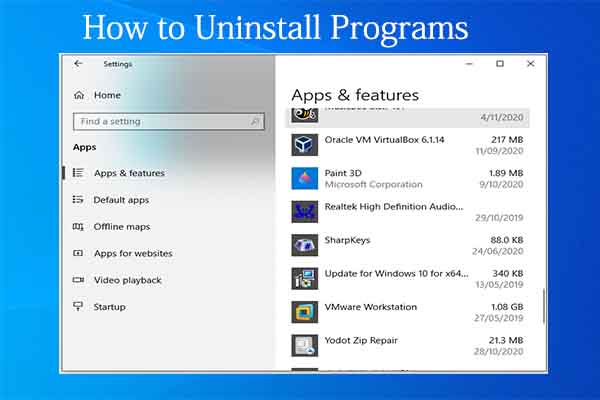Streamlining Your System: An Exhaustive Guide on How to Uninstall Programs in Windows 10

Introduction:
As we navigate the digital realm of Windows 10, optimizing our system’s performance is paramount. Uninstalling unnecessary or outdated programs is a fundamental step towards maintaining a lean, efficient, and responsive operating system. In this comprehensive guide, we’ll delve into the myriad ways users can uninstall programs in Windows 10, exploring built-in tools, advanced techniques, and best practices to streamline your digital experience.
1. Uninstalling Programs via Settings: The User-Friendly Method
Windows 10 offers a user-friendly approach to uninstalling programs through the Settings menu. To initiate the process, click on the Start menu and select the gear-shaped icon for Settings. Within the Settings menu, navigate to “Apps” and then “Apps & features.” Here, you’ll find a list of all installed programs. Select the program you wish to uninstall and click the “Uninstall” button. Follow the on-screen prompts to complete the uninstallation process. This method is ideal for users who prefer a straightforward, graphical interface for program management.
2. Using Control Panel: The Classic Uninstall Hub
While Windows 10 has shifted many settings to the Settings menu, the Control Panel remains a robust hub for system management tasks, including program uninstallation. To access the Control Panel, press Win + X and select “Control Panel.” In the Control Panel, navigate to “Programs” and then “Programs and Features.” Here, you’ll find a list of installed programs. Right-click on the program you want to uninstall and select “Uninstall/Change.” Follow the on-screen instructions to complete the process. This method is reminiscent of earlier Windows versions and suits users familiar with the classic interface.
3. Uninstalling Apps from the Start Menu: A Quick Access Point
For apps installed from the Microsoft Store, users can uninstall them directly from the Start menu. Simply right-click on the app tile in the Start menu and select “Uninstall.” This quick access point is particularly convenient for users who frequently install apps from the Microsoft Store and want a streamlined method for removal. The simplicity of this method aligns with the user-friendly design philosophy of Windows 10.
4. PowerShell Uninstallation: A Scripting Approach
For users comfortable with command-line interfaces and scripting, Windows PowerShell provides a powerful method for uninstalling programs. Press Win + X, select “Windows PowerShell (Admin),” and use the following command:
powershellCopy code
Get-Package -Name [program_name] | Uninstall-Package -Force
Replace [program_name] with the actual name of the program you want to uninstall. This method is ideal for users who prefer a text-based approach and want to automate the uninstallation process.
5. Third-Party Uninstaller Tools: Advanced Program Management
Beyond built-in tools, users can employ third-party uninstaller tools that offer advanced features and functionalities. Programs like Revo Uninstaller, IObit Uninstaller, and Geek Uninstaller provide additional options for thorough program removal, including scanning for leftover files and registry entries. These tools are beneficial for users seeking a more comprehensive uninstallation process and those dealing with stubborn or problematic programs.
6. App Settings for Microsoft Store Apps: Managing Store Installations
For apps installed from the Microsoft Store, users can manage their installations directly through the Microsoft Store app. Open the Microsoft Store, click on the three dots in the top-right corner, and select “My Library.” Here, you’ll find a list of all installed apps. Click on an app, and you’ll see an “Install” button, allowing you to uninstall the app. This method is specifically tailored for Microsoft Store apps and provides an additional avenue for managing these installations.
7. Clean Install and System Reset: A Comprehensive Approach
In some cases, users may opt for a clean install or system reset to remove all programs and start fresh. While this is a more drastic measure, it can be effective in resolving persistent issues, eliminating bloatware, and optimizing system performance. To perform a clean install or system reset, navigate to Settings > Update & Security > Recovery. Here, you’ll find options for resetting your PC while keeping or removing files. Be sure to back up important data before proceeding with this method.
Conclusion: Empowering Users for Efficient Program Management
In conclusion, Windows 10 offers a diverse array of methods for uninstalling programs, catering to users with varying preferences and needs. Whether you choose the user-friendly Settings menu, the classic Control Panel, the quick Start menu access point, PowerShell scripting, third-party uninstaller tools, Microsoft Store app settings, or opt for a clean install or system reset, Windows 10 empowers users with the tools needed to efficiently manage their programs. Incorporating these uninstallation methods into your routine ensures a streamlined and optimized computing experience, allowing you to declutter your system and maintain peak performance in the ever-evolving digital landscape.




